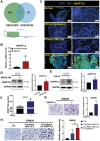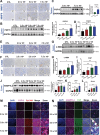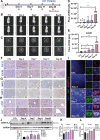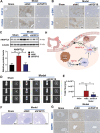FGF19-Activated Hepatic Stellate Cells Release ANGPTL4 that Promotes Colorectal Cancer Liver Metastasis
- PMID: 39716892
- PMCID: PMC11831508
- DOI: 10.1002/advs.202413525
FGF19-Activated Hepatic Stellate Cells Release ANGPTL4 that Promotes Colorectal Cancer Liver Metastasis
Abstract
Liver and lung are the most common metastatic sites in colorectal cancer (CRC), where the tumor microenvironment (TME) plays a crucial role in the progression and metastasis of CRC. Understanding the interactions between various types of cells in the TME can suggest innovative therapeutic strategies. Using single-cell RNA sequencing (scRNA-Seq) and clinical samples, fibroblast growth factor-19 (FGF19, rodent FGF15) is found to mediate a significant interaction between CRC cells and cancer-associated fibroblasts (CAFs), activating the hepatic stellate cells (HSCs)-to-CAFs differentiation. In various CRC metastatic mouse models, it is shown that FGF15 has a more pronounced effect on liver metastasis compared to pulmonary metastasis. More importantly, the differentially expressed genes (DEGs) are also identified from the RNA-Seq dataset upon the activation of HSCs by FGF19 and compared the DEGs in matched primary and metastatic mRNA samples from patients with CRC liver metastasis (CRCLM), it is found that the ANGPTL4 gene is significantly associated with HSCs activation. Different mouse models also demonstrated the impact of the FGF19/ANGPTL4 axis on the severity of CRCLM. Importantly, disruption of this axis significantly inhibits CRCLM in vivo. This study is among the first to demonstrate the impact of the FGF19/ANGPTL4 axis on CRCLM, offering a novel therapeutic strategy.
Keywords: ANGPTL4; FGF19; cancer‐associated fibroblasts; colorectal cancer liver metastasis; tumor microenvironment.
© 2024 The Author(s). Advanced Science published by Wiley‐VCH GmbH.
Conflict of interest statement
The authors declare no conflict of interest.
Figures







Similar articles
-
CXCR4/TGF-β1 mediated hepatic stellate cells differentiation into carcinoma-associated fibroblasts and promoted liver metastasis of colon cancer.Cancer Biol Ther. 2020;21(3):258-268. doi: 10.1080/15384047.2019.1685157. Epub 2019 Dec 11. Cancer Biol Ther. 2020. PMID: 31825725 Free PMC article.
-
Cancer-secreted exosomal miR-1246 promotes colorectal cancer liver metastasis by activating hepatic stellate cells.Mol Med. 2025 Feb 20;31(1):68. doi: 10.1186/s10020-025-01112-w. Mol Med. 2025. PMID: 39979806 Free PMC article.
-
Highly-metastatic colorectal cancer cell released miR-181a-5p-rich extracellular vesicles promote liver metastasis by activating hepatic stellate cells and remodelling the tumour microenvironment.J Extracell Vesicles. 2022 Jan;11(1):e12186. doi: 10.1002/jev2.12186. J Extracell Vesicles. 2022. PMID: 35041299 Free PMC article.
-
The cellular and molecular components involved in pre-metastatic niche formation in colorectal cancer liver metastasis.Expert Rev Gastroenterol Hepatol. 2021 Apr;15(4):389-399. doi: 10.1080/17474124.2021.1848543. Epub 2020 Nov 30. Expert Rev Gastroenterol Hepatol. 2021. PMID: 33174441 Review.
-
Deciphering the possible reciprocal loop between hepatic stellate cells and cancer cells in the tumor microenvironment of the liver.Crit Rev Oncol Hematol. 2023 Feb;182:103902. doi: 10.1016/j.critrevonc.2022.103902. Epub 2023 Jan 5. Crit Rev Oncol Hematol. 2023. PMID: 36621514 Review.
Cited by
-
CRCs-CAFs crosstalk-targeted nano-delivery system reprograms tumor microenvironment for oxaliplatin resistance reversing and liver metastasis inhibition in colorectal cancer.Bioact Mater. 2025 Aug 13;54:126-143. doi: 10.1016/j.bioactmat.2025.08.002. eCollection 2025 Dec. Bioact Mater. 2025. PMID: 40837498 Free PMC article.
-
Brevilin A, a novel LRRC15 inhibitor, exerts potent anti-rheumatoid arthritis effects by inhibiting the LRRC15/STAT3 signaling pathway.Arthritis Res Ther. 2025 Aug 20;27(1):167. doi: 10.1186/s13075-025-03629-1. Arthritis Res Ther. 2025. PMID: 40835949 Free PMC article.
-
The role of ANGPTL4 in cancer: A meta-analysis of observational studies and multi-omics investigation.PLoS One. 2025 Apr 15;20(4):e0320343. doi: 10.1371/journal.pone.0320343. eCollection 2025. PLoS One. 2025. PMID: 40233044 Free PMC article.
-
ANGPTL4: A Comprehensive Review of 25 Years of Research.Cancers (Basel). 2025 Jul 16;17(14):2364. doi: 10.3390/cancers17142364. Cancers (Basel). 2025. PMID: 40723247 Free PMC article. Review.
References
MeSH terms
Substances
Grants and funding
- 2023YFC3502800/National Key Research and Development Program of China
- 82074019/National Natural Science Foundation of China
- 82274158/National Natural Science Foundation of China
- 20222042/Administration of Traditional Chinese Medicine of Guangdong Province
- 20241074/Administration of Traditional Chinese Medicine of Guangdong Province
- 2023KTSCX023/Characteristic Innovation Projects of Universities in Guangdong Province
- 2023A1515011811/Natural Science Foundation of Guangdong Province
- 08193596/Health and Medical Research Fund
- RC-FNRA-IG/23-24/SCM/01/Initial Grant for Faculty Niche Research Areas
- RC-SFCRG/23-24/SCM/02/Seed Funding for Collaborative Research Grants
LinkOut - more resources
Full Text Sources
Medical
